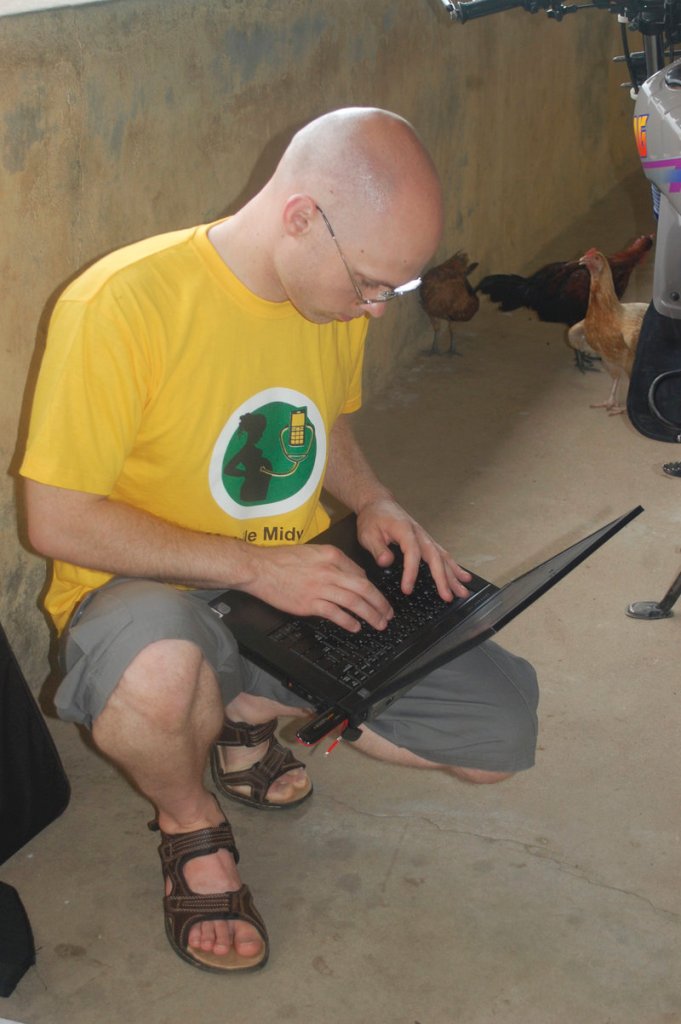PORTLAND – Bruce MacLeod has seen how digital technology can improve medical care in developing countries since he helped introduce computers and floppy disks to Sudanese health centers 30 years ago.
But mobile technology — the ordinary cell phone — is a powerful new tool, according to the University of Southern Maine computer science professor.
MacLeod and two of his graduate students helped create a system that uses cell phones to improve the delivery of health care to pregnant women and newborns in a poor agricultural region of Ghana. The system — known as Mobile Midwife — has been operating since last fall, and parts of it may soon be replicated in India and other poor areas of the world.
Nurses in northeast Ghana can now keep electronic medical records, filling out forms and retrieving patient information using cell phones. And pregnant women and new mothers are getting regular cell phone messages telling them about the importance of good nutrition or reminding them when they are due to get a pre-natal exam or have their child immunized.
“In the last five years, it’s been more about mobile technology, which represents an incredible revolution in the way information is handled,” MacLeod said.
While land-line telephones, laptop computers and the World Wide Web are often not available to the poor, inexpensive cell phones — and the towers to serve them — have become common in remote, rural regions such as northeast Ghana.
“That’s their primary communication,” said Matt Blanchette of Scarborough, who worked full time on the project before and after receiving his master’s degree from USM last year. “Where we have things like Internet connections and Wi-Fi, they really have the cell phone network.”
In northeast Ghana, where families live in rustic compounds, about 60 percent of households now have access to a cell phone, MacLeod said. Some households share, he said, although “everyone wants to own a cell phone.”
In fact, Ghanaians are much more sophisticated with their phones than Americans, he said. They use them to do electronic banking and to check prices at the market, for example.
The Bill and Melinda Gates Foundation saw the potential for improving health with the phones more than two years ago, when it financed a project called Mobile Technology for Community Health. MacLeod and his students were brought into the project by Columbia University to create the applications, or programs. Other partners included the Grameen Foundation, an anti-poverty organization, and the Ghana Health Service.
The Gates Foundation had a simple challenge, MacLeod said: “Can you use mobile phones to save lives?”
It took about two years to create and launch the system. Most of the programming work took place on the USM campus in Portland. MacLeod and Brent Atkinson of Hollis, one of his students, traveled to Ghana to work with nurses and develop and trouble-shoot the system.
Nurses in district health centers now use their phones to fill out electronic forms, such as when a child is born or is immunized. They can easily keep track of exam schedules and look up whether a young mother has had a tetanus shot, or if a family has mosquito netting to prevent malaria.
Before, all record-keeping was on paper, and it took much longer to fill out and retrieve medical information. Saving time is important to the nurses, who serve as the only health care providers in rural areas.
Women in the region are asked to sign up for the message service, and it has become a popular phone app.
The women get periodic calls with recorded health messages. Texting didn’t work because there is no written equivalent for the local language, MacLeod said.
One weekly message might remind pregnant women that mangos are a good source of vitamin A. Another might say that, despite cultural traditions, there is nothing shameful about going to a health center.
Other messages are specific, such as automated reminders when a woman is due for an exam or a child is due for immunization.
It took two years and millions of dollars to create the system from scratch, MacLeod said. USM’s piece of the project cost about $300,000, he said.
But it operates with technology that’s readily available in Ghana.
“One of the things that has everybody’s attention is that we did it with a $40 phone,” MacLeod said. The $40 phones are the ones that nurses use to keep records. Patients can use their standard phones, which typically are sold for $5 or less, he said.
While USM is wrapping up its piece of the project, others will monitor the communities to see whether the technology actually does save lives, such as by reducing infant mortality rates.
“I think it can in the long term,” Blanchette said.
The Gates Foundation and other organizations hope to replicate the system in other parts of Ghana, as well as a region of India that has much higher mortality rates, MacLeod said.
Blanchette said he plans to work on those efforts. Atkinson, the former grad student from Hollis, is now in Kenya working on a similar project.
MacLeod, meanwhile, is leading a new team of graduate students — Brian Hartsock of Oakland and Dave Roberge of Auburn — working to bring digital technology to health centers in Nigeria so they can keep track of health data and trends.
“In a sense, the health system is running blind,” MacLeod said. “We’re going to use the same tricks as in Ghana.”
Staff Writer John Richardson can be contacted at 791-6324 or at:
jrichardson@pressherald.com
Send questions/comments to the editors.



